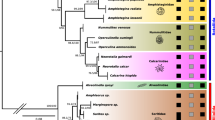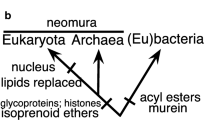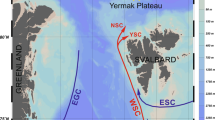Abstract
Phylogenetic analysis of five partial planktic foraminiferal small subunit (SSU) ribosomal (r) DNA sequences with representatives of a diverse range of eukaryote, archaebacterial, and eubacterial taxa has revealed that the evolutionary origin of the foraminiferal lineage precedes the rapid eukaryote diversification represented by the “crown” of the eukaryotic tree and probably represents one of the earliest splits among extant free-living aerobic eukaryotes. The foraminiferal rDNA sequences could be clearly separated from known symbionts, commensals, and food organisms. All five species formed a single monophyletic group distinguished from the “crown” group by unique foraminiferal specific insertions as well as considerable nucleotide distance in aligned regions.
Similar content being viewed by others
References
Bé AWH (1977) An ecological, zoogeographic and taxonomic review of recent planktonic foraminifera. In: Ramsay ATS (ed) Oceanic micropaleontology. Academic Press, New York, pp 1–100
Bé AWH, Hemleben C, Anderson OR, Spindler M, Hacunda J, Tuntivate-Choy S (1977) Laboratory and field observations of living planktonic foraminifera. Micropaleontology 23:155–179
Cavalier-Smith T (1987) Eukaryotes with no mitochondria. Nature 326:332–333
Darling KF, Kroon D, Wade CM, Leigh Brown AJ (1996a) The isolation and amplification of the 18S ribosomal RNA gene from planktonic foraminifers using gametogenic specimens. In: Whatley RC, Moguilevsky A (eds) Microfossils and oceanic environments. Chapter 3.1. University of Wales, Aberystwyth Press, pp 249–259
Darling KF, Kroon D, Wade CM, Leigh Brown AJ (1996b) Molecular evolution of the planktic foraminifera. J Foram Res 26:324–330
Felsenstein J (1978) Cases in which parsimony or compatibility methods will be positively misleading. Syst Zool 27:401–410
Felsenstein J (1981) Evolutionary trees from DNA sequences: a maximum likelihood approach. J Mol Evol 17:368–376
Felsenstein J (1985) Confidence limits on phylogenies: an approach using the bootstrap. Evolution 39:783–791
Felsenstein J (1993) PHYLIP manual version 3.52c. Berkeley University Herbarium, University of California, Berkeley
Fitch WM (1971) Toward defining the course of evolution: minimum change for a specified free topology. Syst Zool 20:406–416
Fitch WM, Margoliash E (1967) Construction of phylogenetic trees. A method based on mutation distances as estimated from cytochrome c sequences is of general applicability. Science 155:279–284
Hasegawa M, Hashimoto T, Adachi J, Iwabe N, Miyata T (1993) Early branchings in the evolution of eukaryotes: ancient divergence of Entamoeba that lacks mitochondria revealed by protein sequence data. J Mol Evol 36:380–388
Hashimoto T, Nakamura Y, Nakamura F, Shirakura T, Adachi J, Goto N, Ojkamoto K, Hasegawa M (1994) Protein phylogeny gives a robust estimation for early divergences of eukaryotes: phylogenetic place of a mitochondria-lacking protozoan,Giardia lamblia. Mol Biol Evol 11:65–71
Hemleben C, Spindler M, Breitinger I, Ott R (1987) Morphological and physiological responses ofGlobigerinoides sacculifer (Brady) under varying laboratory conditions. Marine Micropaleontol 12:305–324
Hemleben C, Spindler M, Anderson OR (1989) Modern planktonic foraminifera. Springer-Verlag, New York
Kishino H, Hasegawa M (1989) Evaluation of the maximum likelihood estimate of the evolutionary tree topologies from DNA sequence data and the branching order of the Hominoidea. J Mol Evol 4:406–425
Knoll AH (1992) The early evolution of eukaryotes: a geological perspective. Science 256:622–627
Langer MR, Lipps JH, Piller WE (1993) Molecular paleobiology of protists: amplification and direct sequencing of foraminiferal DNA. Micropaleontology 39:63–68
Leipe DD, Gunderson JH, Nerad TA, Sogin ML (1993) Small subunit ribosomal RNA ofHexamita inflata and the quest for the first branch in the eukaryotic tree. Mol Biochem Parasitol 59:41–48
Loomis WF, Smith DW (1990) Molecular phylogeny ofDictyostelium discoideum by protein sequence comparison. Proc Natl Acad Sci USA 87:9093–9097
Maidak BL, Larsen N, McCaughey MJ, Overbeek R, Olsen GJ, Fogel K. Blandy J, Woese CR (1994) The ribosomal database project. Nucleic Acids Res 22:3484–3487
Merle C, Moullade M, Lima O, Perasso R (1994) An attempt to phylogenetically characterise some planktonic foraminifers on the basis of 28S rDNA partial sequences. C R Acad Sci II Sci Terre Planetes 319:149–153
Neefs J, Van de Peer Y, Hendriks L, De Wachter R (1990) Compilation of small ribosomal subunit RNA sequences. Nucleic Acids Res 18:2237–2242
Pawlowski J, Bolivar I, Guiard-Maffia J, Gouy M (1994) Phylogenetic position of foraminifera inferred from LSU rDNA sequences. Mol Biol Evol 11:929–938
Saitou N, Nei M (1987) The neighbor-joining method: a new method for reconstructing evolutionary trees. Mol Biol Evol 4:406–425
Schlegel M (1991) Protist evolution and phylogeny as discerned from small subunit ribosomal RNA sequence comparisons. Eur J Protistol 27:207–219
Smith SW, Overbeek R, Woese CR, Gilbert W, Gillevet PM (1994) The genetic data environment an expandable GUI for multiple sequence analysis. Comput Appl Biosci 10:671–675
Sogin ML (1989) Evolution of eukaryotic microorganisms and their small subunit ribosomal RNAs. Am Zool 29:487–499
Sogin ML (1991) Early evolution and the origin of eukaryotes. Curr Opin Genet Dev 1:457–463
Wainwright PO, Hinkle G, Sogin ML, Stickel SK (1993) Monophyletic origins of the metazoa: an evolutionary link with fungi. Science 260:340–342
White TJ, Bruns T, Lee S, Taylor J (1990) Amplification and direct sequencing of fungal ribosomal RNA genes for phylogenetics. In: Innis MA, Gelfand DH, Sninsky JJ, White TJ (eds) PCR protocols: a guide to methods and applications. Harcourt Brace Jovanovich, San Diego, pp 315–322
Wray CG, Langer MR, DeSalle R, Lee JJ, Lipps JH (1995) Origin of the foraminifera. Proc Natl Acad Sci 92:141–145
Yang Z, Roberts D (1995) On the use of nucleic acid sequences to infer early branchings in the tree of life. Mol Biol Evol 12:451–458
Author information
Authors and Affiliations
Rights and permissions
About this article
Cite this article
Wade, C.M., Darling, K.F., Kroon, D. et al. Early evolutionary origin of the planktic foraminifera inferred from small subunit rDNA sequence comparisons. J Mol Evol 43, 672–677 (1996). https://doi.org/10.1007/BF02202115
Received:
Accepted:
Issue Date:
DOI: https://doi.org/10.1007/BF02202115




